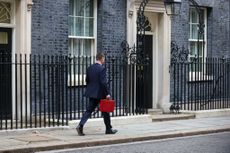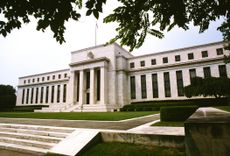When lockdown ends, be prepared for an inflationary surprise
The government is pouring more money into the economy to tide businesses over the latest lockdown. Once lockdown ends, says John Stepek,we should see a significant bounceback in demand – and in inflation.


In summer last year, as Covid-19 eased off for a bit, chancellor Rishi Sunak was beginning to drop hints about tightening the purse strings again. Or at least, suggesting that he was considering how he’d go about slowing the growth in Britain’s debt pile, rather than adding to it at a rate of knots.
That was a little premature, of course. By the end of 2020, the furlough scheme had already been extended significantly. And now that we’re all in an even tighter lockdown once again, there’s really only one option for the Treasury – to chip in even more assistance to the businesses and industries that will be forced to shut down.
Businesses in the hardest-hit sectors will now be eligible for one-off grants of up to £9,000, the chancellor announced this morning. The size of the grant depends on the rateable value of the business – £4,000 for those with a rateable value of below £15,000; £6,000 for up to £51,000; and £9,000 for those above £51,000.
Subscribe to MoneyWeek
Subscribe to MoneyWeek today and get your first six magazine issues absolutely FREE

Sign up to Money Morning
Don't miss the latest investment and personal finances news, market analysis, plus money-saving tips with our free twice-daily newsletter
Don't miss the latest investment and personal finances news, market analysis, plus money-saving tips with our free twice-daily newsletter
The Treasury reckons about 600,000 businesses in retail, leisure and hospitality will be eligible. The aim is to tide businesses over until at least the start of March, which is when the next Budget is scheduled to take place. That’s likely to contain a more detailed plan for longer-term support and recovery.
That’ll be useful because while the various bits of money being thrown at struggling businesses no doubt help, it doesn’t make it easy to plan for the future – if indeed there is one for many of these firms. Business shut down, emergency support, the threat of recession – these are all things we’d normally associate with a disinflationary shock. But these aren’t normal times.
From a broader economic perspective, the decision to carry on with essentially no-questions-asked direct assistance for businesses puts all the late summer, early autumn concerns about “austerity” into perspective. The government can’t and won’t put the brakes on for some time yet.
According to a survey in the Financial Times today, investors already believe that the Bank of England is using quantitative easing (QE – printing money to buy government bonds) to keep government borrowing costs down. In other words, the Bank is printing money for the government to spend.
The Bank might deny that (the official line is that QE is designed to help keep inflation close to the 2% target) but it’s pretty clear that this is all semantics. The Bank of England magics up money. It conveniently buys gilts at a time when the government is issuing lots of them. The government then gives the money to crisis-hit businesses. Whether those businesses survive or not is beside the point in macroeconomic terms. Money that did not previously exist has gone into the economy.
This is what makes the current version of QE so different from the post-2008 central bank activity. The process itself isn’t any different. The important difference is that the money isn’t sitting with bankrupt commercial banks. It’s being handed out by the government.
So that’s inflationary, however you look at it. Then on top of that, it’s also worth noting that consumers are still keen to shop from companies that are able to meet their demands. In other words, we don’t have a deflationary demand shock because consumers still want to spend and still have the resources to do so.
A Christmas trading update from high street clothes chain Next showed that sales in the nine weeks to Boxing Day were just 1.1% down on 2019. The company (admittedly well-known for managing expectations lower, then beating them) had pencilled in an 8% drop, notes The Guardian. The collapse in offline sales was largely compensated for by a jump in online sales.
Also worth noting is the pandemic’s impact on stock levels – Next chief executive Simon Wolfson pointed out that deliveries from the far east are running late, with stock set to return to normal “by the end of March”.
If Next is struggling with stock, you can be sure that other chains are too. Supply chain disruption adds to costs. Will those costs be passed onto consumers? At a time when domestic savings are high (on average), and the propensity to spend on available outlets is apparently still pretty solid, it would be very surprising if businesses didn’t at least try.
In short – after 2008, money printing did nothing because the banks were bust, and consumers were too (partly as a result of the banks being bust). This time, consumers haven’t been anywhere near as hard hit, the banks are fine, and in many cases they’re either being directed to lend by the government (bounceback loans) or bypassed altogether (grants).
This is not a recipe for deflation. Once lockdown ends (and it will, at some point), this remains a recipe for a significant bounceback in demand - and in inflation.
John is the executive editor of MoneyWeek and writes our daily investment email, Money Morning. John graduated from Strathclyde University with a degree in psychology in 1996 and has always been fascinated by the gap between the way the market works in theory and the way it works in practice, and by how our deep-rooted instincts work against our best interests as investors.
He started out in journalism by writing articles about the specific business challenges facing family firms. In 2003, he took a job on the finance desk of Teletext, where he spent two years covering the markets and breaking financial news. John joined MoneyWeek in 2005.
His work has been published in Families in Business, Shares magazine, Spear's Magazine, The Sunday Times, and The Spectator among others. He has also appeared as an expert commentator on BBC Radio 4's Today programme, BBC Radio Scotland, Newsnight, Daily Politics and Bloomberg. His first book, on contrarian investing, The Sceptical Investor, was released in March 2019. You can follow John on Twitter at @john_stepek.
-
 Coventry Building Society bids £780m for Co-operative Bank - what could it mean for customers?
Coventry Building Society bids £780m for Co-operative Bank - what could it mean for customers?Coventry Building Society has put in an offer of £780 million to buy Co-operative Bank. When will the potential deal happen and what could it mean for customers?
By Vaishali Varu Published
-
 Review: Three magnificent Beachcomber resorts in Mauritius
Review: Three magnificent Beachcomber resorts in MauritiusMoneyWeek Travel Ruth Emery explores the Indian Ocean island from Beachcomber resorts Shandrani, Trou aux Biches and Paradis
By Ruth Emery Published
-
 UK wages grow at a record pace
UK wages grow at a record paceThe latest UK wages data will add pressure on the BoE to push interest rates even higher.
By Nicole García Mérida Published
-
 Trapped in a time of zombie government
Trapped in a time of zombie governmentIt’s not just companies that are eking out an existence, says Max King. The state is in the twilight zone too.
By Max King Published
-
 America is in deep denial over debt
America is in deep denial over debtThe downgrade in America’s credit rating was much criticised by the US government, says Alex Rankine. But was it a long time coming?
By Alex Rankine Published
-
 UK economy avoids stagnation with surprise growth
UK economy avoids stagnation with surprise growthGross domestic product increased by 0.2% in the second quarter and by 0.5% in June
By Pedro Gonçalves Published
-
 Bank of England raises interest rates to 5.25%
Bank of England raises interest rates to 5.25%The Bank has hiked rates from 5% to 5.25%, marking the 14th increase in a row. We explain what it means for savers and homeowners - and whether more rate rises are on the horizon
By Ruth Emery Published
-
 UK wage growth hits a record high
UK wage growth hits a record highStubborn inflation fuels wage growth, hitting a 20-year record high. But unemployment jumps
By Vaishali Varu Published
-
 UK inflation remains at 8.7% ‒ what it means for your money
UK inflation remains at 8.7% ‒ what it means for your moneyInflation was unmoved at 8.7% in the 12 months to May. What does this ‘sticky’ rate of inflation mean for your money?
By John Fitzsimons Published
-
 VICE bankruptcy: how did it happen?
VICE bankruptcy: how did it happen?Was the VICE bankruptcy inevitable? We look into how the once multibillion-dollar came crashing down.
By Jane Lewis Published